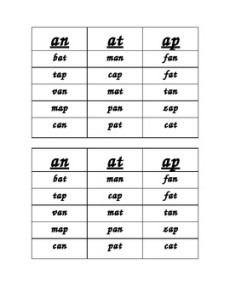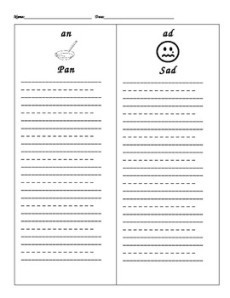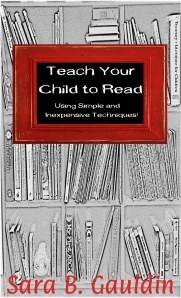Teach Your Child to Read: c + at makes cat!
When your child has a firm knowledge of the sounds that individual letters represent, it is time to build upon that knowledge with the introduction of word families. Word families are exactly what the name suggests; words that are related by sharing a common root or ending sound. The most classic example of a word family is the “at” family, which includes cat, sat, fat, mat, rat, hat and later words like flat and slat. Word families are a great way to help your child transition from the discovery of letter sounds using chunks of sounds to create actual words that have meanings which they recognize.
Try This!
Most children who understand letter sounds will readily accept two-letter combinations. I recommend that you begin with teaching the “at” family. Label a note card “at.” Label several other cards with the consonants’ b, c, f, h, m, p, r, s, and v. Guide your child to sound out the letters in “at” until they are confident that the letter pair says “at.” Using one consonant card at a time, have your child review the sound the letter makes. When they correctly identify the sound, place the card in front of the “at” card so that the word is in proper order. Place your child’s finger on the consonant, then repeat its sound. After you have practiced the consonant sound, place your child’s finger on the “at” card, then repeat the sound. Repeat the introduction to the paired sounds on the cards with greater speed. Most children will make the connection and read the word created by adding the consonant to the word family fairly quickly. If trouble persists, continue to model the blending for your child. Say to them “Fff… at, Fff..at, Fff.at makes fat.” When your child has successfully mastered the “at” family you may move on to other ‘short a’ families such as “ap,” “an” and “ad.” Introduce them separately and practice each set for several days before moving to the next feature. I like to progress somewhat alphabetically. Stick to the two-letter families to begin with. Later, you can work up to the three-letter families like –ack.

Another great strategy that I rely on heavily is word sorting. At the word family stage, it is best to introduce a few word families as described above, and then compare the families using a sort. Word family sorts will feature two to three families. Word sorts come as one page with scrambled blocks that must be cut apart. It is advisable to have the child place his or her finger under each word, then have him or her repeat the word after you say it (echo read) before the words are ever separated. Once the words are cut apart, the child will need to find the header that indicates what each column should contain. Often, there is a guide word that is either attached to the heading, or distinguished by bold or underlined letters. The guide word goes under the header. Work with your child for the first few words. As you take each word from the stack, decide together which column of words the word should belong in. Once all words are sorted, have your child re-read each column aloud to you. The child should place a finger on each word as it is read.
There are many other activities that can be used with the sort. One option is timing a speed sort where speed and accuracy count. Another option is giving the child only the headers and having them complete a “blind sort”; you call out the word, and they point to the header that it belongs with. After extensive practice, I have my students write the words in the columns to help them to cement the distinction in their minds. I have many pre-made sorts available;
an, at, and ap sort, http://www.teacherspayteachers.com/Product/Word-Sort-Word-
et and en sort, http://www.teacherspayteachers.com/Product/Word-Sort-features-the-word-family-et-and-en-539237
eck, ell, en sort, http://www.teacherspayteachers.com/Product/Word-Sort-eck-ell-en-539228
it, ip, ig sort, http://www.teacherspayteachers.com/Product/Word-Sort-Word-Families-it-ip-and-ig-539319
it, in, ick sort, http://www.teacherspayteachers.com/Product/Word-Sort-Word-Families-it-in-ick-539349
ot, ob, op sort, http://www.teacherspayteachers.com/Product/Word-Sort-Word-Family-ot-ob-op-539462
ob, op, ock, ot sort, http://www.teacherspayteachers.com/Product/Word-Sort-Word-Family-ob-op-ock-ot-539454
all, ill, ell sort, http://www.teacherspayteachers.com/Product/Word-Sort-all-ill-and-ell-371208
ock, ack ick sort . http://www.teacherspayteachers.com/Product/Word-Sort-for-ock-ack-ick-444347

Another technique that I find helpful is a writing sort. After the child has been introduced to two or more word families, a writing sort can be used to compare the sounds and words made by the families. Writing sorts have pre-divided sections. Call out a word from any labeled section and let the child decide which section the word belongs in. When they have decided on a word’s best placement, have them write the word to the best of their ability in that section. Emphasize that they should spell the word based on the sounds that they hear. Once written, reveal the real answer and have the child make any corrections if needed. It is important to encourage the child to compare the correct spelling of the word to their own work and to erase and fix mistakes when applicable. I have several pre-made writing sorts available;
an, ad writing sort, http://www.teacherspayteachers.com/Product/Writing-Sort-Word-Family-an-ad-539197
at, ap writing sort,. http://www.teacherspayteachers.com/Product/Writing-Sort-Word-Family-at-ap-539204
an, ad, at, ap writing sort, http://www.teacherspayteachers.com/Product/Writing-Sort-Word-Family-an-ad-at-ap-539213
it, in writing sort, http://www.teacherspayteachers.com/Product/Writing-Sort-it-and-in-539356
it, ick, ig, in writing sort, http://www.teacherspayteachers.com/Product/Writing-Sort-it-ick-ig-and-in-539371
op, ot writing sort, http://www.teacherspayteachers.com/Product/Writing-Sort-op-and-ot-539423
ot, og ock writing sort, http://www.teacherspayteachers.com/Product/Writing-Sort-Word-Family-ot-og-and-ock-539397
ack, ick uck writing sort http://www.teacherspayteachers.com/Product/Writing-Sort-for-ack-ick-uck-444353
Media can be helpful when learning word families. There are many commercially made videos, games and devices that focus on word families. Leapfrog offers several videos on this topic. The second listing on www.starfall.com has an entire column of word families that make a nice review. Many devices for young children focus on this skill extensively. The trick is finding the source that your child can focus on and encouraging him or her to use that source.
As with any reading skill, authentically reading materials with the featured word family is the best way to help your child begin to connect the dots and actually but the skill into practice. Visit your local library and explain to your librarian that your child is learning about word families. He or she will most likely have some book recommendations of publications that are available and offer examples of these features that are appropriate for beginning readers. When choosing a book, try to stick to one with a few words or a single sentence on each page. Help your child to look at the pictures on each page, in order and talk about what each page shows before reading the book. After you have completed your “picture walk” of the story you are ready to read. Put your finger under each word as your read them aloud. Have your child put their finger under each word as they echo the words behind you. Try to read the text in meaningful chunks and break for punctuation. It is okay to split a sentence into multiple parts. I usually use the words I can say comfortably in one breath as a stopping place when punctuation does not stop me first. After some practice with the page have your child help you to search for words form a given word family that appear on the page. Ask: “Do you see any words that are on the áp’ family?” Help your child to find and re read the themed words. You may even want to ask the child to practice writing the words they find as an added means of concreting the word and its pattern in their minds.
Related articles
Toys and Activities that Promote Creativity and Intelligence (kidzedge.com)
How to Harness the Visual Powers of the Right-Brained Learner (child-1st.typepad.com)
Teaching Your Child Good Listening Skills (akronscienceschool.com)
Take Your Child to a Bookstore Day! (eccentricchai.com)






